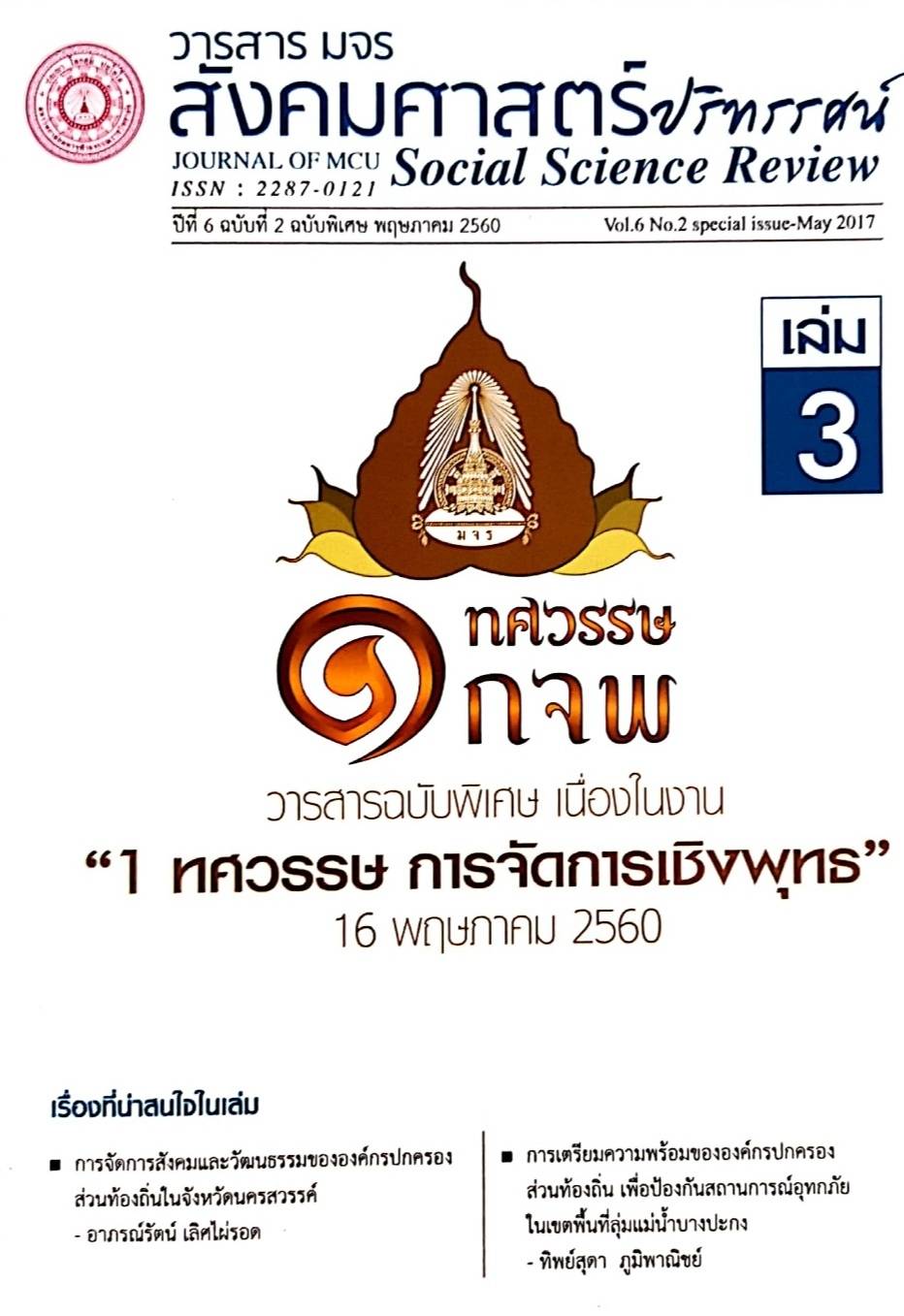แรงงานคุณภาพอาชีวศึกษาสู่เศรษฐกิจไทยแลนด์ 4.0
คำสำคัญ:
แรงงานคุณภาพ, อาชีวศึกษา, เศรษฐกิจไทยแลนด์ 4.0บทคัดย่อ
บทความนี้มีวัตถุประสงค์เพื่อสังเคราะห์สภาพปัญหา โครงสร้างความต้องการแรงงานและแนวทางในการพัฒนาแรงงานคุณภาพอาชีวศึกษาสู่เศรษฐกิจไทยแลนด์ 4.0 สถานการณ์แรงการของประเทศไทยในปัจจุบัน บทบาทการพัฒนาอาชีวศึกษา แรงงานคุณภาพอาชีวศึกษาในงานวิจัย เพื่อให้สอดคล้องกับการพัฒนาเศรษฐกิจไทยแลนด์ 4.0 โดยแรงงานคุณภาพอาชีวศึกษาถือเป็นกลไกสาคัญสู่การขับเคลื่อนการเจริญเติบโตทางเศรษฐกิจในภาคอุตสาหกรรมของประเทศไทยตามกรอบยุทธศาสตร์ชาติ 20 ปี และแผนพัฒนาเศรษฐกิจและสังคมแห่งชาติ ฉบับที่ 12เพื่อกาหนดทิศทางการพัฒนาและเสริมสร้างศักยภาพทรัพยากรมนุษย์สู่การเป็นประเทศไทย 4.0 ตามนโยบายประเทศไทย 4.0 กับการผลิตกาลังด้านอาชีวศึกษาดังนั้น แนวทางการพัฒนาแรงงานคุณภาพอาชีวศึกษาจึงมีความจาเป็นอย่างยิ่งที่จะต้องวางแผนและพัฒนากาลังคนเป้าหมาย โดยมีความร่วมมือภาครัฐ ภาคเอกชน สถาบันการศึกษา และการศึกษาวิจัยโดยเร่งด่วนในรูปแบบเอกชนนา รัฐและเอกชนร่วมวางแผน ตามบริบทการเปลี่ยนแปลงและภาพอนาคตของสังคมไทยที่ส่งผลต่อการศึกษาอาชีวศึกษา รวมถึงการพัฒนาทักษะแรงงานที่ตรงตามความต้องการของตลาด เพื่อสนับสนุนการพัฒนาประเทศ
เอกสารอ้างอิง
กลุ่มยุทธศาสตร์และแผนการประชาสัมพันธ์สานักโฆษกรัฐบาลไทย. (2558). รายการคืนความสุขให้คนในชาติ. สืบค้นเมื่อ 1 เมษายน 2558, จากhttp://www.thaigov.go.th/.
จงจิตต์ ฤทธิรงค์และรีนา ต๊ะดี. (2558). ข้อท้าทายในการผลิตแรงงานฝีมือไทยเพื่อเข้าสู่ตลาดแรงงานประชาคมเศรษฐกิจอาเซียน. สถาบันวิจัยประชากรและสังคมมหาวิทยาลัยมหิดล.
ณัฐพงษ์ อิ่มสมัย. (2558). ความต้องการบุคลากรด้านอาชีวศึกษา ภายหลังการรวมกลุ่มประชาคมเศรษฐกิจอาเซียนในปี พ.ศ. 2558. มหาวิทยาลัยหัวเฉียวเฉลิมพระเกียรติ.
เรวดี นามทองดี. (2558). การอาชีวศึกษากับการพัฒนาศักยภาพแรงงานไทยในการเป็นประชาคมอาเซียน. สถาบันทรัพยากรมนุษย์ มหาวิทยาลัยธรรมศาสตร์.
อุดม วงศ์วิวัฒน์ไชย. (2558). ชี้ทางรอดวิกฤติขาดแคลนแรงงาน.http://www.mbamagazine.net/
ปรีชา อุปโยคิน และคณะ. (2557). การศึกษาความต้องการแรงงานและพัฒนาฝีมือแรงงานในภูมิภาคลุ่มน้ำโขง.
กรวิทย์ ตันศรี และสิรีธร จารุธัญลักษณ์. (2555). ความไม่สมดุลของตลาดแรงงานไทยนัยของการขาดแคลนแรงงาน. ขอนแก่น : ส่วนเศรษฐกิจภาค ธนาคารแห่งประเทศไทยสำนักงานภาคตะวันออกเฉียงเหนือ.
วรากรณ์ สามโกเศศ. (2552). เรื่องน่ารู้เกี่ยวกับสมรรถนะ. มติชนรายวัน, หน้า 6.
สุวกิจ ศรีปัดถา. (2546). การปฏิบัติงานตามหลักธรรมาภิบาลของสถาบันอุดมศึกษา ศึกษาเฉพาะ กรณีสถาบันราชภัฏมหาสารคาม. มหาสารคาม : สถาบันราชภัฏมหาสารคาม.
พุทธ ธรรมสุนา. (2554). ผลิตและพัฒนากำลังคนอาชีวศึกษาอย่างไรให้ตรงกับความต้องการของภาคอุตสาหกรรม. คณะครุศาสตร์อุตสาหกรรม มหาวิทยาลัยเทคโนโลยีพระจอมเกล้าพระนครเหนือ.
ดาวน์โหลด
เผยแพร่แล้ว
รูปแบบการอ้างอิง
ฉบับ
ประเภทบทความ
สัญญาอนุญาต
ลิขสิทธิ์ (c) 2020 วารสาร มจร สังคมศาสตร์ปริทรรศน์

อนุญาตภายใต้เงื่อนไข Creative Commons Attribution-NonCommercial-NoDerivatives 4.0 International License.
เพื่อให้เป็นไปตามกฎหมายลิขสิทธิ์ ผู้นิพนธ์ทุกท่านต้องลงลายมือชื่อในแบบฟอร์มใบมอบลิขสิทธิ์บทความให้แก่วารสารฯ พร้อมกับบทความต้นฉบับที่ได้แก้ไขครั้งสุดท้าย นอกจากนี้ ผู้นิพนธ์ทุกท่านต้องยืนยันว่าบทความต้นฉบับที่ส่งมาตีพิมพ์นั้น ได้ส่งมาตีพิมพ์เฉพาะในวารสาร มจร สังคมศาสตร์ปริทรรศน์ เพียงแห่งเดียวเท่านั้น หากมีการใช้ภาพหรือตารางหรือเนื้อหาอื่นๆ ของผู้นิพนธ์อื่นที่ปรากฏในสิ่งตีพิมพ์อื่นมาแล้ว ผู้นิพนธ์ต้องขออนุญาตเจ้าของลิขสิทธิ์ก่อน พร้อมทั้งแสดงหนังสือที่ได้รับการยินยอมต่อบรรณาธิการ ก่อนที่บทความจะได้รับการตีพิมพ์ หากไม่เป็นไปตามข้อกำหนดเบื้องต้น ทางวารสารจะถอดบทความของท่านออกโดยไม่มีข้อยกเว้นใดๆ ทั้งสิ้น





